The 1946 Washington Quarter is among the few issues that don’t have Proof and Special Strike coins. But the year boasts a couple of die varieties that attract the interest of coin specialists. Aside from that, it generally has a higher value even for the lowest coin grade compared to the latter dated quarters.
As per our research, a 1946 Quarter in the circulated condition is valued between $4.65 and $7.25, while an uncirculated condition sells for higher, valued at $30 to $6,500, depending on the variety. Below, you’ll see the abridge estimated value of the 1946 Quarter based on their grade and origin.
| 1946 Quarter Value Chart | |||
| Coin Grade | 1946 (P) Quarter | 1946-D Quarter | 1946-S Quarter |
| Circulated
(PO-1 to XF-40) |
$4.70 | $4.70 | $4.70 |
| About Uncirculated
(AU-50 to AU-58) |
$5.25-$7.25 | $5.25-$7.25 | $5.25-$7.25 |
| Uncirculated
(MS-60 to MS-64) |
$10-$27.50 | $10-$27.50 | $10-$27.50 |
| Gem Uncirculated
(MS-65 and above) |
$37.50-$2,950 | $37.50-$4,000 | $30-$6,500 |
1946 Washington Quarter History
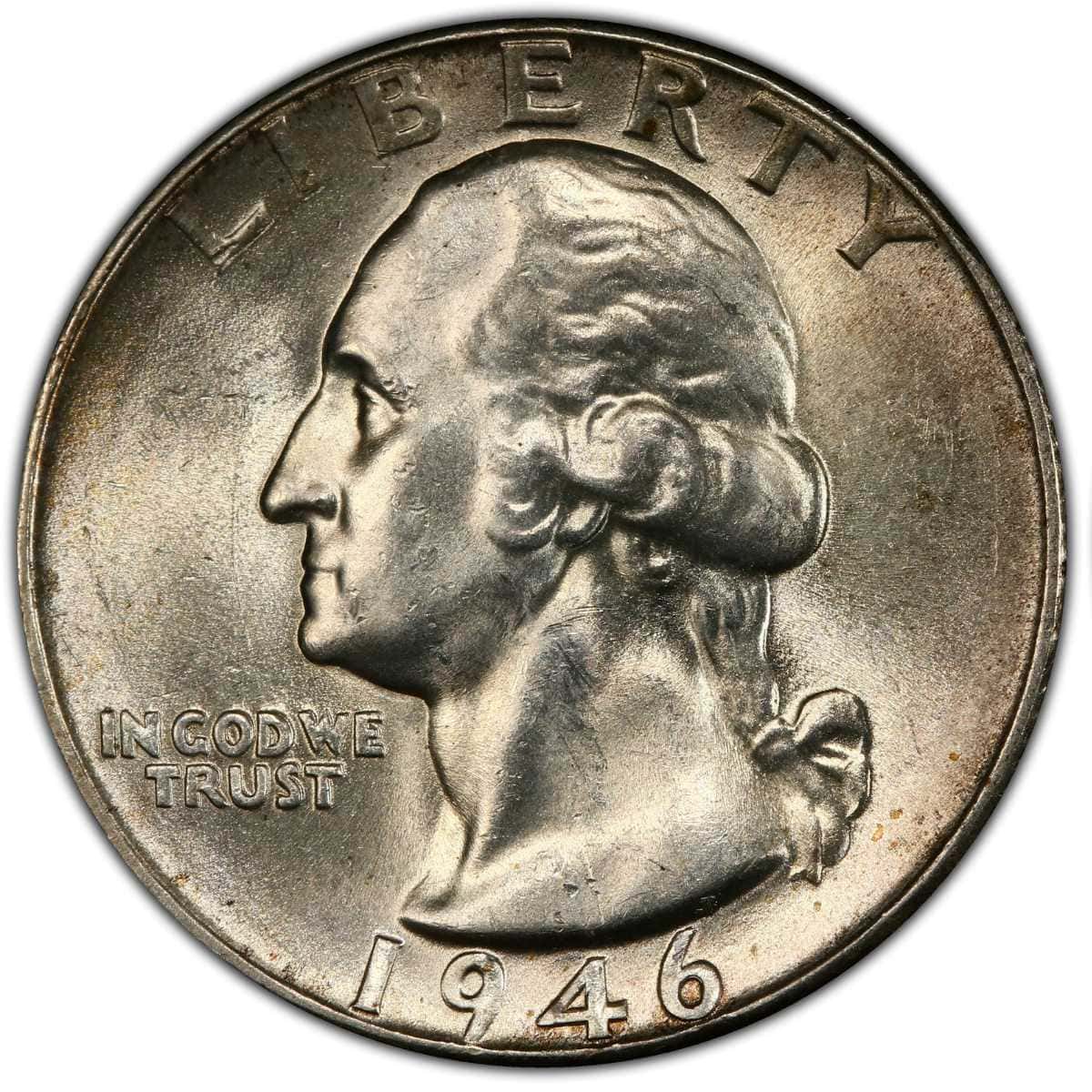
The 1946 Quarter is part of the Washington Quarter Silver series from 1932 to 1964 before transitioning to clad for five years. Philadelphia, Denver, and San Francisco minted over 66 million regular strike 1946 quarters. However, no Proof nor Special Strike coins appeared for collectors to purchase this year.
Keeping at least one of the two strikes was not an option after the country experienced hardship from World War II. The economic pressure led the Mints to suspend producing proof coinage from 1943 through 1949. Proof coins only returned in 1950 with modest production after a long hiatus.
Here’s a glance at the detailed mintage number from each coin facility of the 1946 Quarter. Then, later, we’ll comprehensively discuss which grades are common and scarce.
| Mint Location | Mintage | Series |
| Philadelphia | 53,436,000 | 1946 (P) Quarter |
| Denver | 9,072,800 | 1946-D Quarter |
| San Francisco | 4,204,000 | 1946-S Quarter |
1946 Quarter Specification and Design Details
- Category: Washington Quarters (1932-1964)
- Face Value: 25 Cents
- Obverse-Reverse Designer: John Flanagan
- Metal Composition: 90% Silver, 10% Copper
- Weight: 6.30 grams
- Diameter: 24.30 millimeters
- Edge: Reeded
The Washington Quarter coin first appeared in 1932, replacing the Standing Liberty Quarter. In John Flanagan’s original design, he featured the bust of George Washington facing towards the left on the obverse side.
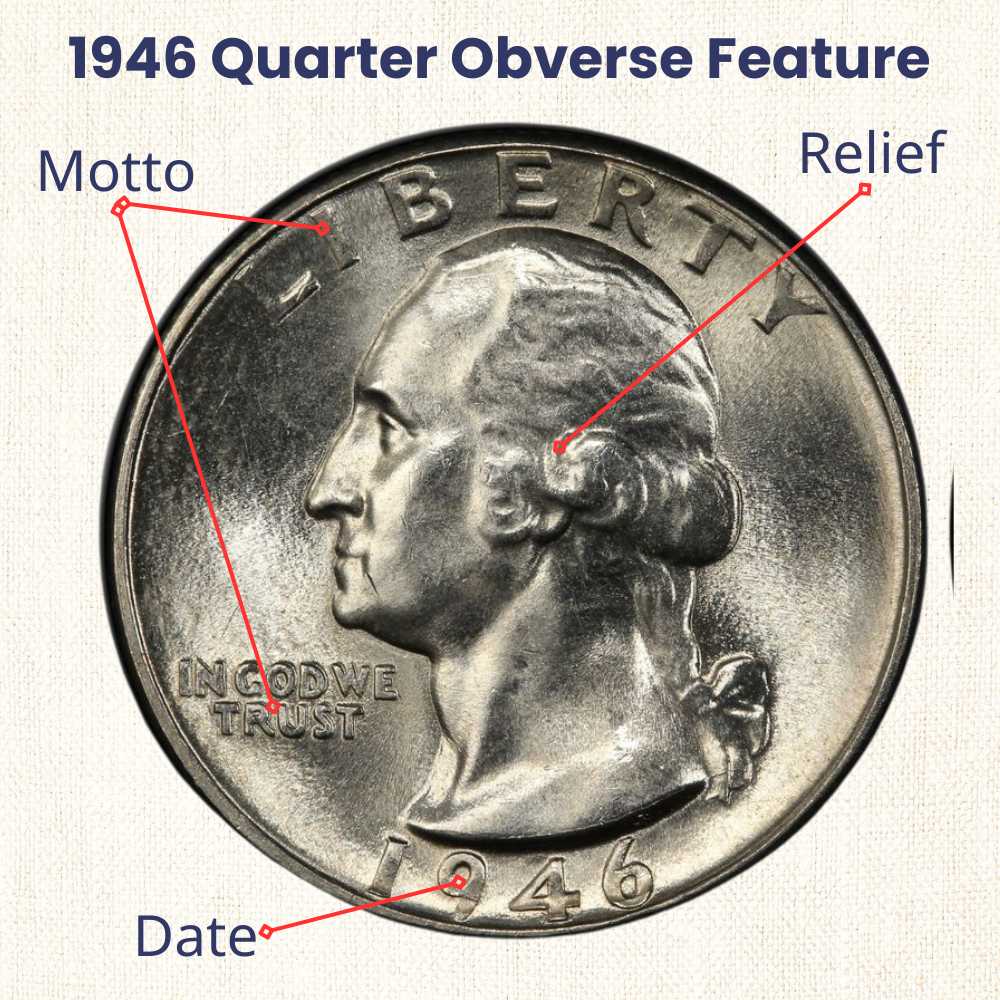
However, this changed recently, with the president’s portrait facing right by Laura Fraser after an intentional design choice. With the obverse inscription, you’ll find the words LIBERTY, IN GOD WE TRUST, and the year evenly spaced on the coin’s surface.

Moving to the reverse side is an eagle with its wings spread out while standing on a bundle of arrows. Underneath is an olive wreath and the coin denomination—QUARTER DOLLAR. Lastly, the words UNITED STATES and E PLURIBUS UNUM arch above the familiar emblem.
1946 (P) Washington Quarter Value
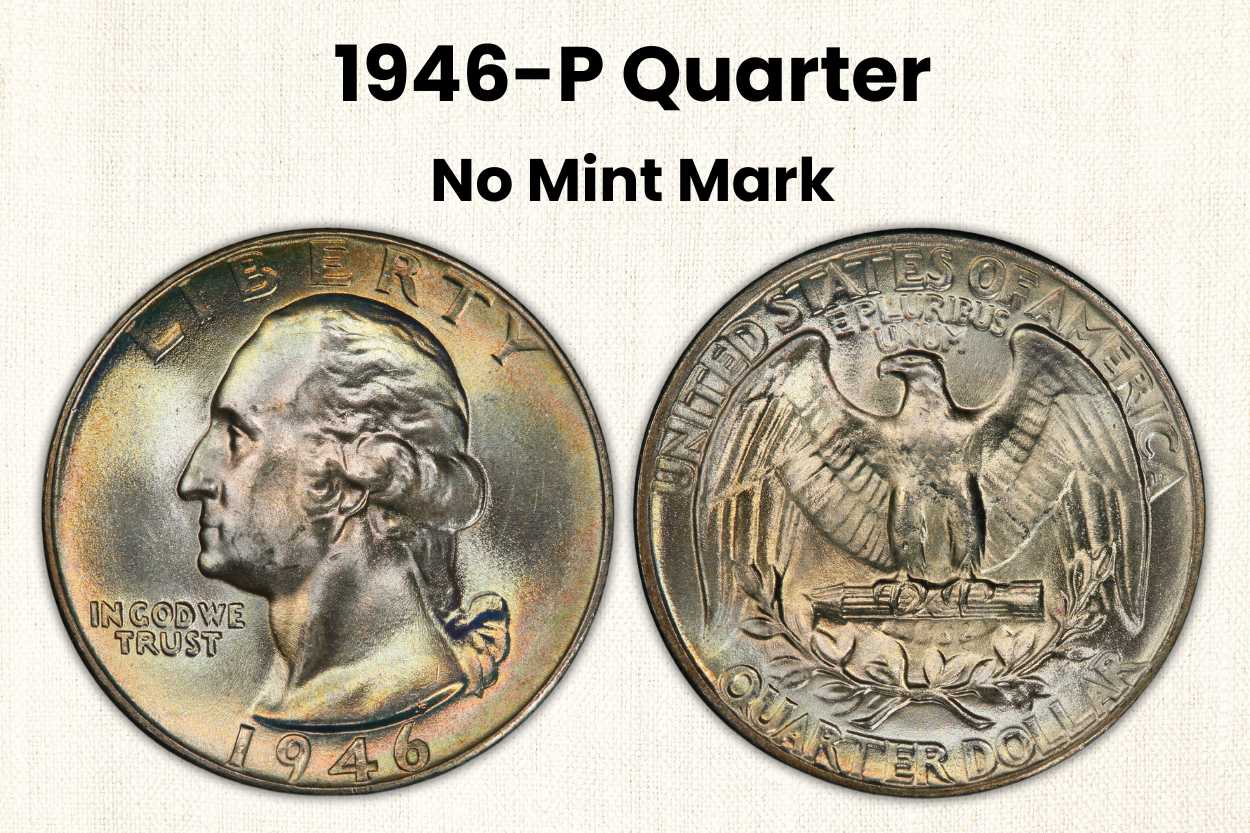
The postwar period mintage is relatively high since Mints focused only on regular strike coins. The 1946 (P) is plentiful in circulated condition. But those in Gem conditions are among the trickiest dates to acquire out of other 1940s dated-quarter.
So, how did it happen if Philadelphia released more than the average coinage? Well, the root cause goes all the way back after a decade of release.
During the peak of coin collecting in the 1950s and ‘60s, people focused on dates with lower mintage and ignored those that had relatively high production, including the 1946 Quarter. Only a few uncirculated rolls survived from the hands of the general public, thus the low number of Gem condition samples.
Today, a circulated condition 1946 (P) quarter is valued at $4.70 to $7.25, a couple of dollars higher than its face value because of its silver metal composition.
Meanwhile, an uncirculated condition can go from $10 to $2,950. The 1946 (P) Quarter in Gem condition is much scarcer than the 1946-S Quarter despite San Francisco producing the lowest mintage this year. For this reason, an MS67 can seamlessly sell for $2,000 and above in open auctions.
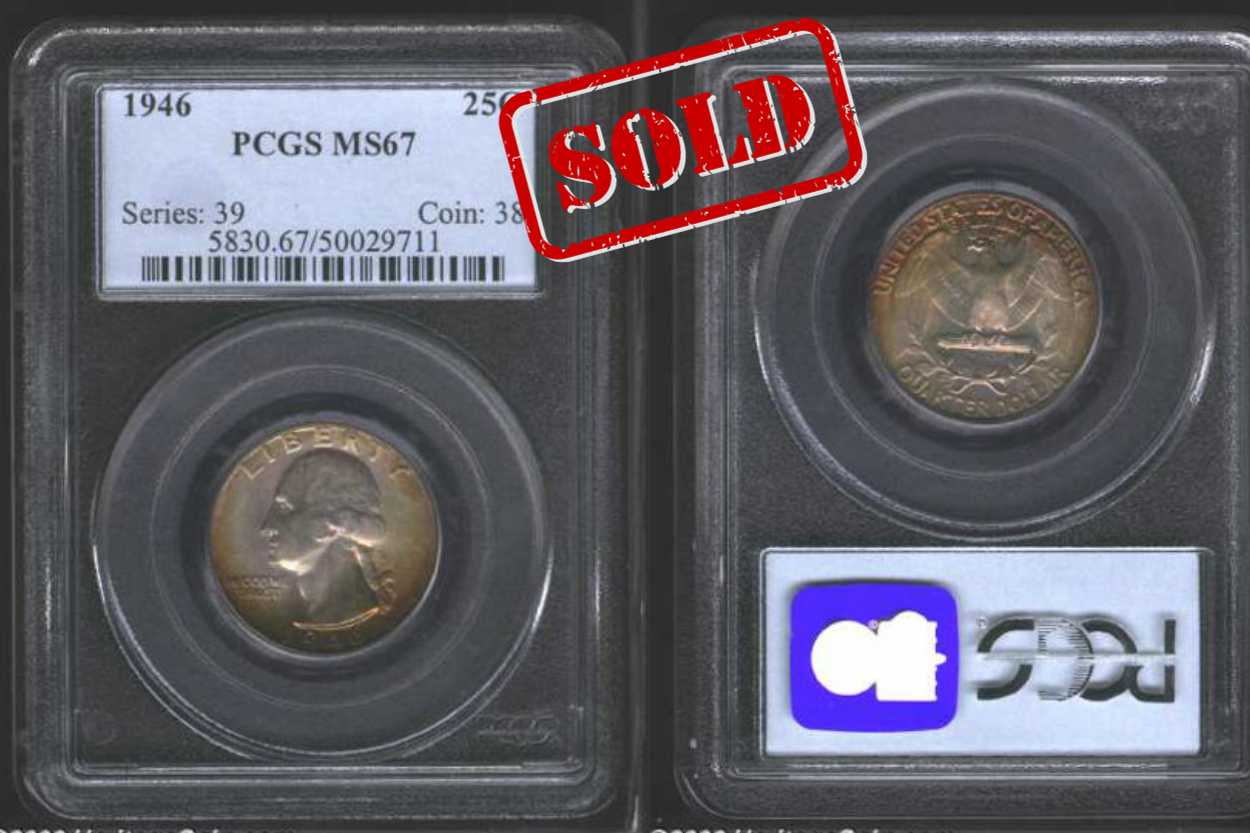
An example is the 1946 25C MS67 sold for $8,050 by Heritage Auctions.
| 1946 (P) MS Quarter Value | |
| Coin Grade | Estimated Value |
| MS-60 | $10-$11 |
| MS-61 | $12-$13 |
| MS-62 | $15-$16 |
| MS-63 | $17.50-$20 |
| MS-64 | $25-$27.50 |
| MS-65 | $37.50-$45 |
| MS-66 | $75-$125 |
| MS-67 | $850-$2,950 |
1946-D Washington Quarter Value
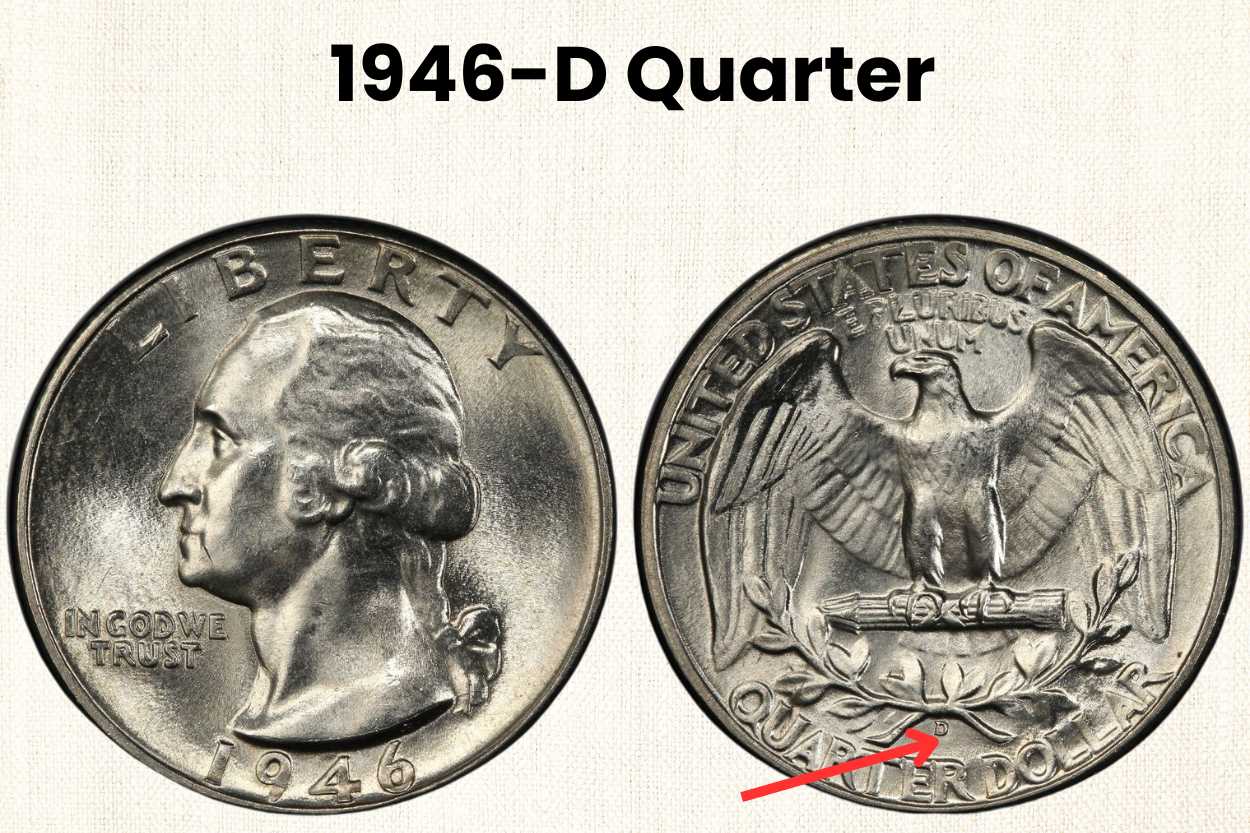
While Philadelphia had a prosperous minting after the war, it is a different case for the Denver Mint. In 1946, the coin production fell below 10 million for the first time since 1940.
There is no exact explanation as to why they hit a downfall. However, one thing is definite: the 1946-D is generous in number, even those in Gem conditions. To validate it, the MS67 has the highest samples recorded under Mint state condition with over a thousand population.
In terms of valuation, a 1946-D Quarter in circulated condition stands at $4.70 to $7.25. On the other hand, the uncirculated condition is somewhat similar to the no-mint mark variety, with an estimated value of $10 to $2,250 for MS60 to MS67.
The quarters produced from Denver typically have excellent luster and strike, making the MS68 attainable and the highest grade available for this variety. Today, a 1946-D MS68 is worth $4,000, but it goes a couple of thousand dollars higher if placed in big auctions.
| 1946-D MS Quarter Value | |
| Coin Grade | Estimated Value |
| MS-60 | $10-$11 |
| MS-61 | $12-$13 |
| MS-62 | $15-$16 |
| MS-63 | $17.50-$20 |
| MS-64 | $25-$27.50 |
| MS-65 | $37.50-$45 |
| MS-66 | $55-$100 |
| MS-67 | $225-$2,250 |
| MS-68 | $4000 |
1946-S Washington Quarter Value
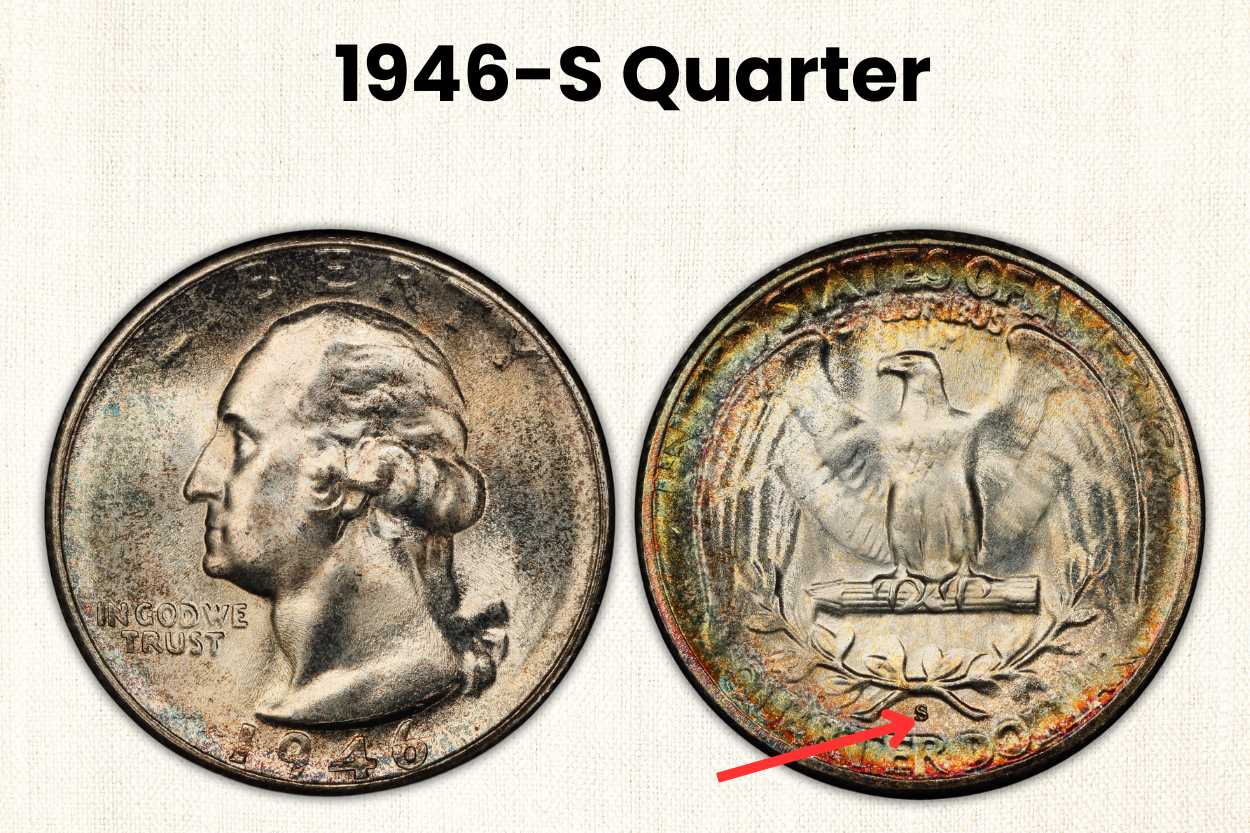
The postwar economic downturn enveloped the San Francisco Mint in 1946. As a result, the coin facility ranked second with the lowest mintage from 1940 to 1946.
But despite the sudden drop, it has a bountiful number of coins in Gem condition. As we mentioned, many collectors keep an eye on low-mintage varieties. They hoard BU rolls to preserve their value, and they did not fail, as many spectacular samples appear today.
Circulated condition 1946-S is worth the same as the previous varieties, playing between $4.70 to $7.25, and, as expected, the uncirculated condition from MS60 to MS67 is a few dollars lower, valued at around $10 to $700 because of its high survival estimate.
A grade MS68, however, is an exception as it can reach a tremendous $6,500 and higher in auctions. As per our research, the highest record for an MS68 has a sale price of $14,950 under Bowers & Merena in 2011.
| 1946-S MS Quarter Value | |
| Coin Grade | Estimated Value |
| MS-60 | $10-$11 |
| MS-61 | $12-$13 |
| MS-62 | $15-$16 |
| MS-63 | $17.50-$20 |
| MS-64 | $25-$27.50 |
| MS-65 | $30-$35 |
| MS-66 | $65-$85 |
| MS-67 | $325-$700 |
| MS-68 | $6,500 |
1946 Quarter Die Varieties and Their Valuation
In the postwar era, all federal departments and agencies, including the Mints, had declined budget to compensate for the economic loss. With this, the quality of the US coins stumbled for the next few years. Mints maximized the life of the dies, making ideal strikes hard to maintain across all new coins.
Aside from the die overuse, it also reveals the different die varieties made during this year. There are DDO and DDR, but it is the RPM that collectors specifically look for. In this section, we’ll tackle the die varieties in the 1946 Quarter, including their current estimated market value.
1946 25C DDO FS-101

Doubled Die Obverse or DDO shows a duplicate image or inscription on the coins’ obverse side. It is common in coins dated 1997 rearwards because of the hubs used.
In earlier dates, like 1946, one impression is not enough to completely transfer the design from the hub to the die. Due to this, the die is reheated and prepared for a second impression. When the mint workers fail to align the hub and the working die precisely the second time, it can result in a doubled die.
Coins punched with the flawed die may present with a prominent doubling in the letters LIBE of the word LIBERTY, the motto IN GOD WE TRUST, and the digits 1946 on the obverse side. DDO die variety coins, depending on their condition, can sell from $12 to $375.
1946 25C DDR FS-801
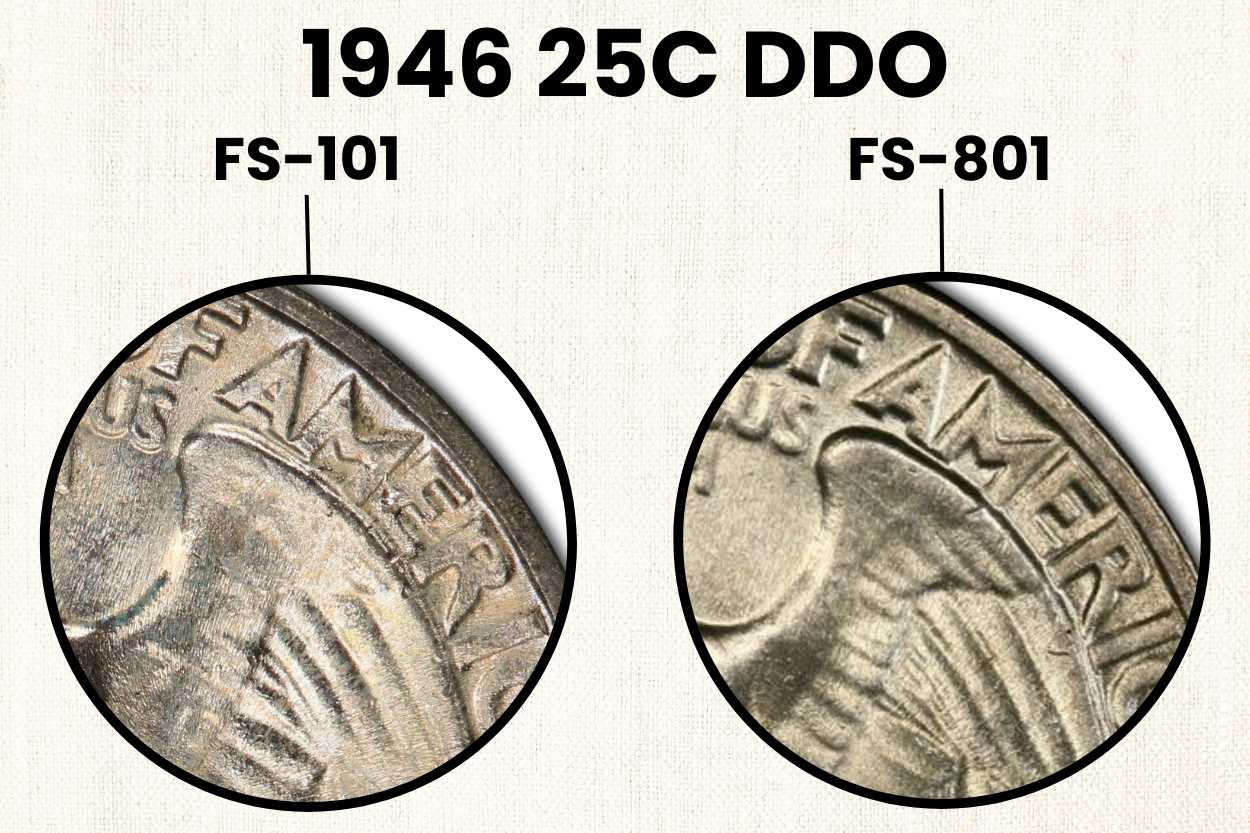
Doubled Die Reverse or DDR has a similar origin to DDO, except the doubling is seen on the reverse side. You’ll find the doubling more prominent on the words STATES OF AMERICA and QUARTER DOLLAR.
A 1946 DDR can sell higher than a DDO because of the limited samples recorded. It can range from $12 to $1,300. As of today, the highest record for a DDR variety has a sale price of $1,260 for an MS65.
1946 25C RPM FS-501
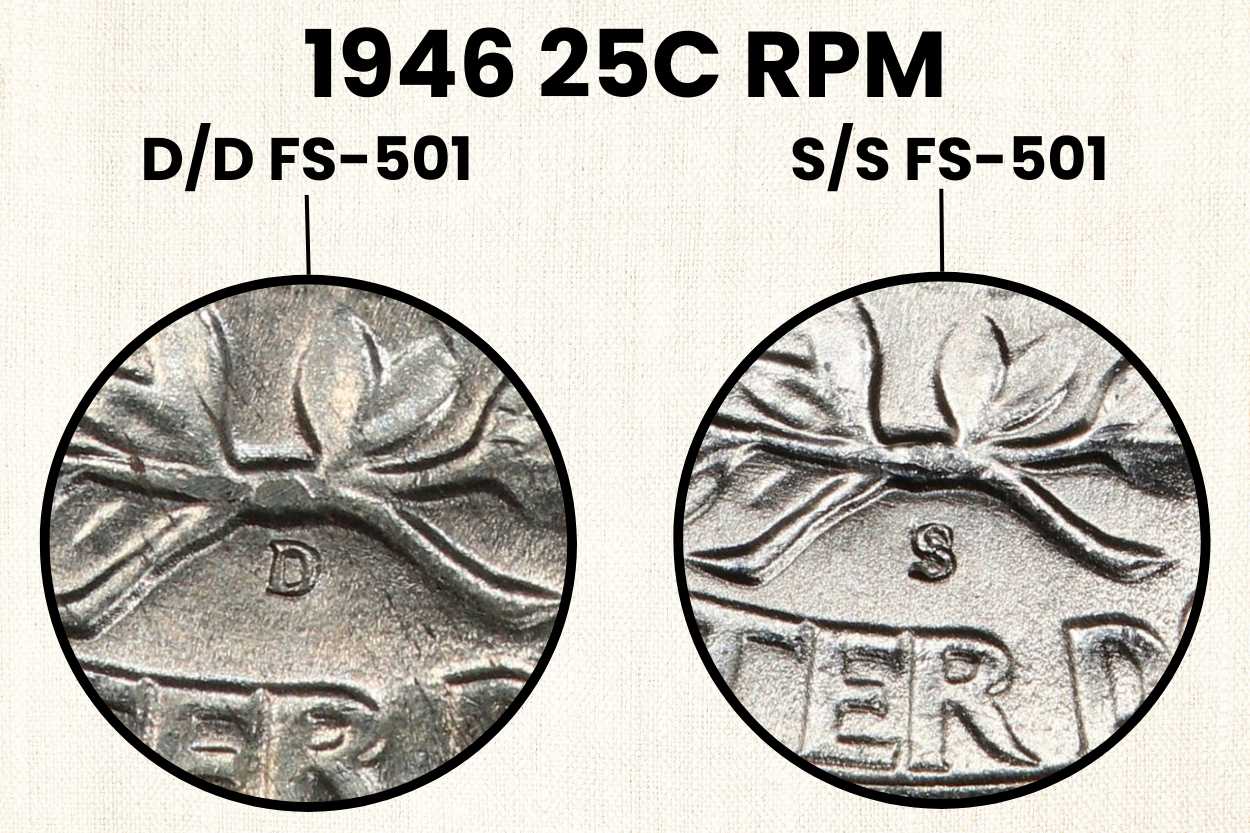
A repunched mintmark or RPM has two or more offset impressions of the mintmark on the punched coin. Typically, the letter overlaps where the primary mintmark is thicker and the second a lot thinner and smaller.
There are two mintmark die varieties for the 1946 quarter: the 1946-D/D and a 1946-S/S Quarter RPM. Both have subtle doubling but can still elevate the value of the coin. A 1946-D/D Quarter RPM can sell for around $20 to $900, while a 1946-S/S is valued at $12 to $2,300.
The 1946-S/S is sought after by many collectors, especially those in MS67 grade. Looking at the auction records, the highest-graded sample, MS67+, was sold for $3,819 by Heritage Auctions in 2013.
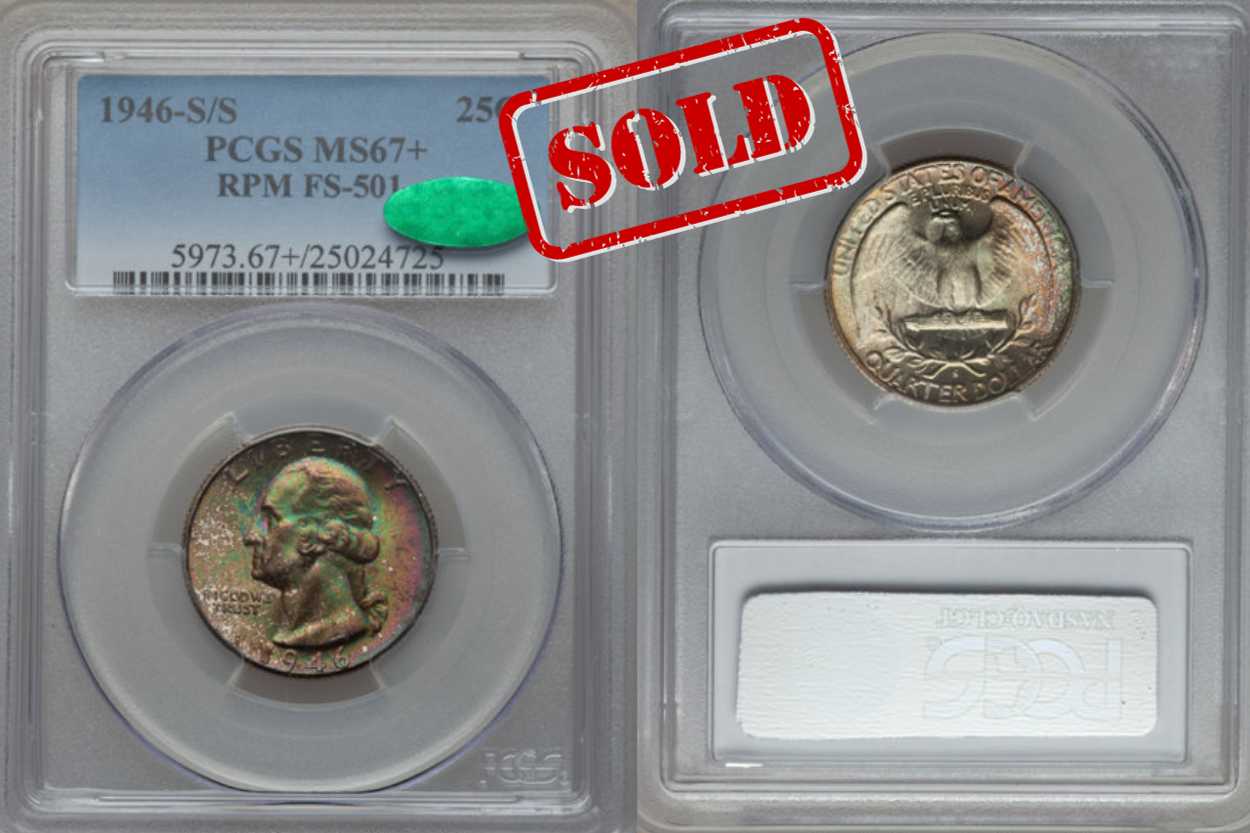
Note: The FS label on the coins denotes Fivaz-Stanton numbers (from the book Cherrpicker’s Guide to Rare Die Varieties of United States Coin). It helps to identify each coin variety using their initials “FS” and a designated number. An FS-101 is an obverse doubled die or obverse die variety, while an FS-501 is a mintmark variety.
1946 Washington Quarter Error Coins
Unlike the abundant 1946 die varieties, error coins are limited, with only a few specimens available on online coin-selling platforms. In addition, errors do not drastically increase the coins’ market value since most collectors prefer those with DDO, DDR, and RPM. But let’s look at a few 1946 Quarter error coins you might encounter and their estimated worth.
1946 25C Lamination Error

Lamination error (or appropriately delamination error) is caused by a disruption in the coin’s metal mixture. During the mixing process, contaminants can go into the alloy and cause the coin’s surface to separate. The impurities can be as small as a needle or sometimes as big as a coin.
Lamination crack is its common consequence, and you’ll notice it if one side of the coin lifts at a superficial level. Coins with minor lamination errors can sell for a few dollars, but prominent ones can fetch up to $25 to $50.
1946 25C Struck On the Wrong Planchet
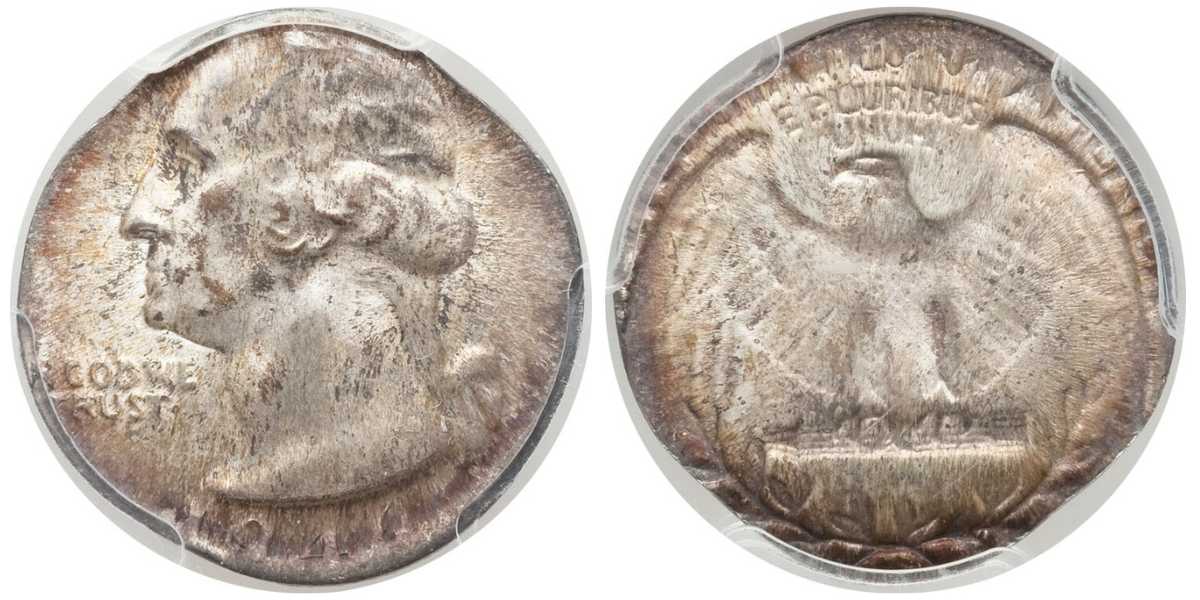
A few samples of the 1946 Washington Quarter struck on a dime planchet appeared in auctions and sold for a reasonable amount. But before we get into its valuation, let’s briefly talk about what caused the flaw.
From the name of the error, a wrong planchet gets fed in a coin-stamping press with a quarter die. Since quarters have enormous designs, some elements usually disappear when struck on a smaller planchet like the dime.
In terms of value, it differs depending on the misfed planchet. A Washington Quarter struck on a silver planchet can sell for $300 to $650. However, quarters struck on a clad planchet sell for lower, at around $250 to $400.
1946 25C Planchet Flaw
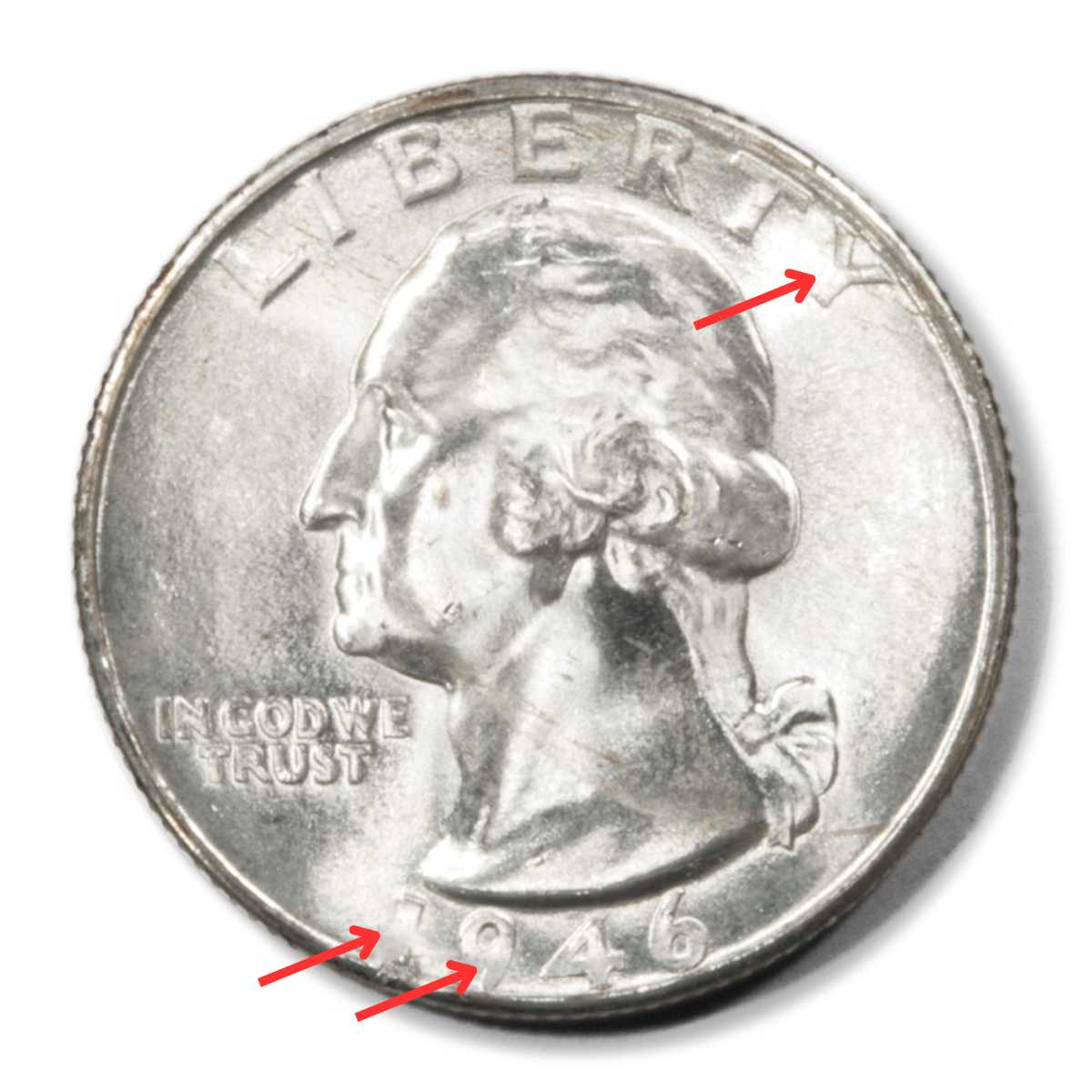
A planchet flaw may come in different forms. It could be an irregular hole on the coin’s surface or a striation from a defective blank. Sometimes, these flaws can affect the elements in the coin or obliterate some inscriptions.
Now, the question is, would this affect the coin’s value? It depends on the gravity of the error. Dramatic flaws that can decrease eye appeal can lower its worth. However, there are decent errors that can elevate it by a few hundred dollars from the original estimated value.

Jenson is a professional numismatist, a dedicated coin collector, a graduate of the College of Business at Oregon State, a life member of the American Numismatic Association (ANA), and an overall coin nerd. He is the founder of Coin Value List.
